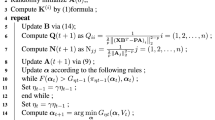Abstract
The kernel minimum squared error (KMSE) expresses the feature extractor as a linear combination of all the training samples in the high-dimensional kernel space. To extract a feature from a sample, KMSE should calculate as many kernel functions as the training samples. Thus, the computational efficiency of the KMSE-based feature extraction procedure is inversely proportional to the size of the training sample set. In this paper, we propose an efficient kernel minimum squared error (EKMSE) model for two-class classification. The proposed EKMSE expresses each feature extractor as a linear combination of nodes, which are a small portion of the training samples. To extract a feature from a sample, EKMSE only needs to calculate as many kernel functions as the nodes. As the nodes are commonly much fewer than the training samples, EKMSE is much faster than KMSE in feature extraction. The EKMSE can achieve the same training accuracy as the standard KMSE. Also, EKMSE avoids the overfitting problem. We implement the EKMSE model using two algorithms. Experimental results show the feasibility of the EKMSE model.
Similar content being viewed by others
Explore related subjects
Discover the latest articles and news from researchers in related subjects, suggested using machine learning.References
Muller KR, Mika S, Ratsch G, Tsuda K, Scholkopf B (2001) An introduction to kernel-based learning algorithms. IEEE Trans Neural Netw 12(2):181–201
Vapnik VN (1999) An overview of statistical learning theory. IEEE Trans Neural Netw 10(5):988–999
Kim KI, Jung K, Kim HJ (2002) Face recognition using kernel principal component analysis. IEEE Signal Process Lett 9(2):40–42
Mika S, Ratsch G, Weston J, Scholkopf B, Mullers KR (1999) Fisher discriminant analysis with kernels. In: Proceedings of the 1999 IEEE signal processing society workshop neural networks for signal processing IX, pp 41–48
Xu J, Zhang X, Li Y (2001) Kernel MSE algorithm: a unified framework for KFD, LS-SVM and KRR, in Neural Networks, 2001. In: Proceedings. IJCNN ‘01. International joint conference on, vol 2. pp 1486–1491
Saunders C, Gammerman A, Vovk V (1998) Ridge regression learning algorithm in dual variables. Presented at the proceedings of the 15th international conference on machine learning, vol 37. pp 515–521
Suykens JAK, Vandewalle J (1999) Least squares support vector machine classifiers. Neural Process Lett 9(3):293–300
Baudat G, Anouar F (2000) Generalized discriminant analysis using a kernel approach. Neural Comput 12(10):2385–2404
Zhang C, Nie F, Xiang S (2010) A general kernelization framework for learning algorithms based on kernel PCA. Neurocomputing 73(4–6):959–967
Wang J, Li Q, You J, Zhao Q (2011) Fast kernel Fisher discriminant analysis via approximating the kernel principal component analysis. Neurocomputing 74(17):3313–3322
Xu Y, Yang J-Y, Yang J (2004) A reformative kernel Fisher discriminant analysis. Pattern Recogn 37(6):1299–1302
Xu Y, Zhang D, Jin Z, Li M, Yang J-Y (2006) A fast kernel-based nonlinear discriminant analysis for multi-class problems. Pattern Recogn 39(6):1026–1033
Zhao Y-P, Du Z-H, Zhang Z-A, Zhang H-B (2011) A fast method of feature extraction for kernel MSE. Neurocomputing 74(10):1654–1663
Zhu Q (2011) Reformative nonlinear feature extraction using kernel MSE. Neurocomputing 73(16–18):3334–3337
Xu Y, Yang J-Y, Lu J-F (2005) An efficient kernel-based nonlinear regression method for two-class classification, in machine learning and cybernetics, 2005. In: Proceedings of 2005 international conference on, vol 7. pp 4442–4445
Zheng Y-J, Yang J, Yang J-Y, Wu X-J (2006) A reformative kernel Fisher discriminant algorithm and its application to face recognition. Neurocomputing 69(13–15):1806–1810
Zhao Y-P, Sun J-G, Du Z-H, Zhang Z-A, Zhang H-B (2011) Pruning least objective contribution in KMSE. Neurocomputing 74(17):3009–3018
Zhao Y-P, Sun J-G (2009) Recursive reduced least squares support vector regression. Pattern Recogn 42(5):837–842
Author information
Authors and Affiliations
Corresponding author
Rights and permissions
About this article
Cite this article
Wang, J., Wang, P., Li, Q. et al. Improvement of the kernel minimum squared error model for fast feature extraction. Neural Comput & Applic 23, 53–59 (2013). https://doi.org/10.1007/s00521-012-0813-9
Received:
Accepted:
Published:
Issue Date:
DOI: https://doi.org/10.1007/s00521-012-0813-9




